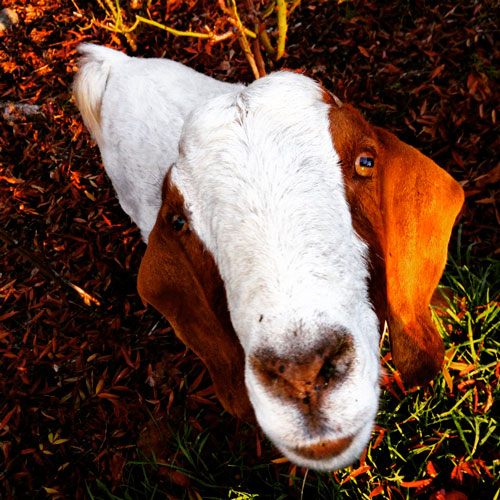
So there we were on our new hobby farm, with all the tall grass and gum tree saplings thriving on our 30-acre hill, worrying about potential bushfire. ‘Let’s get some goats,’ we heard ourselves say. They can keep the growth down and will be fun to have as pets!’ What a great idea!
To get the place ready, we spent about six grand having new fences put up, then installed the electric part of the fence ourselves. Did I mention we used to live in the city and had no idea what we were doing?
We somehow got it all to work and were ready for the goats to be delivered. A truck came up our driveway loaded with these beautiful Boer goats from South Africa. These are meat goats and not to be confused with dairy goats or goats bred for their wool.
One by one the goats jumped off the truck and into the paddock where they leapt about and had mini fights, rearing up and crashing their heads against each other. We found them fascinating and often took a drink and stood in the paddock watching them.

They are mesmerising and if you spend time with them, you see their different personalities, markings and the pack mentality. Also, you see which are the dominant goats and which are always last to get any food as they cower in the background.
We learned so much, including the terminology: bucks (boys); does (girls); in kid (pregnant); drench (give oral medication); and, of course, joining (when a man and a woman love each other very much and are married they perform this act.)
And we also did things I never thought I’d do. Ear tagging (hint: they don’t like this and let out the loudest scream when it pierces their ear); drenching (it takes one person to hold them and another to administer the medicine); and hoof trimming (you cut their cloven hoofs with secateurs, not pleasant).
When food was scarce we bought bales of lucerne hay and gave them a few slices and they would run down the hill with the sound of a stampede, dust billowing behind them.
Seeing as we enjoyed having them so much, we thought it was time to let them have some babies. We ‘borrowed’ a buck, and when he was delivered we noticed the pungent smell of chevre! And he wasn’t a dairy goat.
That musky smell does crazy things for the ladies as they all danced around him wiggling their tails (yes, really) trying to attract him. Well, within two minutes of his arrival, he was ‘on the job’. As we stood there watching his immense prowess, we wondered about what we should name him. My then 11-year-old son Louis said, ‘How about “Tiger” as in Tiger Woods!’ So, Tiger it was.
As they usually have twins, a few months later our herd almost tripled in size. Some of the mother goats were very maternal and did all the right things, like feeding and protecting the kids, while others just walked off with afterbirth still coming out as if saying, ‘It wasn’t me’. Their babies were the ones we had to hand feed. It was winter, so we often kept them in the house in our unused old spa bath and brought them out to bottle-feed. These became our favourite goats, as they stayed quite tame and even now come up to let us pet them.
Naming the goats was always fun, so to keep an idea of how old they were, we chose names with a different theme each year. One year’s goats were named after singers, including Rihanna and Beyonce. Another year followed the modern trend for made-up and creatively spelled names, with my favourite being Chardonnae Breeze.
Even though we loved the babies, we had to get rid of all the boys to prevent inbreeding. So another adventure was the first trip to the abattoir. My wife, Lisa, didn’t want to go as she found it heartbreaking, so I drove them down to Wangaratta with my brother and sister-in-law and we herded them into a small corral. After I filled out the paperwork and left them behind, we felt a bit sad so to ease our devastation, we went to visit a nearby winery!
Five years have passed and in that time, we have had a few more randy bucks, litters and visits to the abattoir. But we decided this year it was time to reduce the numbers right down. We had little feed in the paddock and it was costing $70 a week in lucerne. So I put an ad in the local paper and a man with 200 acres full of rampant blackberry, which he wanted gone, was happy to buy them from us.
We spent three hours chasing them up and down our paddock full of rocks, grabbing them by their horns, crash-tackling them to the ground and shoving them into his ute. They are off to a better place full of feed and space and we have kept our four favourites: Meg, Sahara, Lucky and Ginger.
It was all worth it, as we enjoyed our foray into goat raising and have great stories to tell. Meanwhile, did I tell you about our sheep, Matthew, whose life we saved? Stay tuned …

